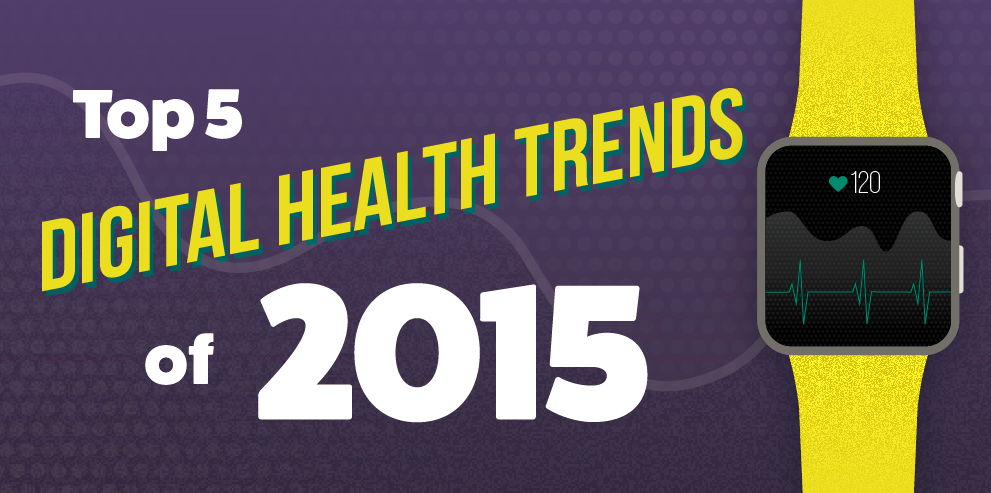It’s an exciting time in health care. We’re in the midst of a digital health boom, with big investments and rapid advances being made in the field. According to data from the digital health venture fund Rock Health, 2014 was a record-breaking year for digital health funding, and those numbers held steady in 2015, surpassing $4.3B in funding. What were the most important trends in health care and technology in 2015? And what’s in store for 2016? Let’s take a look.
Wearables as diagnostic tools. Last year, we predicted that wearables would be big in 2015 and we were right. The technology has moved beyond fitness trackers to tools that actually diagnose health problems.
For instance, researchers at the University of California, San Diego, have developed a “smart mouth guard” that uses electronic sensors to detect certain chemicals in saliva that can be associated with muscle fatigue and various metabolic disorders, reports the MIT Technology Review. The device wirelessly transmits the information it collects to a smartphone or computer. More testing is necessary, but a noninvasive diagnostic device like this could be useful to athletes, soldiers, pilots, and even hospital patients.
A new report by PricewaterhouseCoopers (PwC) found that 50 percent of consumers would use a do-it-yourself diagnostic test for conditions including urinary-tract infections and strep throat. Check out Consumer Reports’ roundup of recommended FDA-approved DIY tests for blood glucose monitoring, cholesterol, and more.
Virtual doctor visits/telemedicine. Another important finding in the PwC report is that 60 percent of consumers say they would be open to a virtual doctor’s visit. A recent survey of physicians found that nearly the same percentage of doctors—57 percent—are in favor of video visits. And as we reported in June, major insurers including UnitedHealthcare and Kaiser Permanente are now covering video doctor visits for patients. Earlier this year Walgreens introduced $49 digital doctor visits as an extension of their popular walk-in clinics.
Companies offering virtual care and telehealth are flooding the marketplace, and PwC found that primary care practices are working with or plan to work with telecommunications companies more than other new entrants into the health care industry—even more than medical device manufacturers. Analysts expect the global market for telemedicine to exceed $30 billion by 2020, according to PwC.
3D printing. “3D printing took the cake as far as being the most impactful trend in digital health today,” reported the Tech Times, recapping the 2015 International CES Digital Health Summit. 3D printing is one of the fastest growing technologies in health care. The 3D printing market for health care will generate more than four billion dollars by 2018, according to a report by Visiongain.
The panel at CES predicted the use of 3D printing in medical education to advance significantly in the next few years. “The ability to print models of a heart for a medical student to operate on and to provide that safeguarded, practical method for students is helping 3D printing bring digital health into the future,” states the Tech Times.
The ‘maker movement.’ 3D printing will also help grow what’s being called the “maker movement.” While DIY has been big in crafting and other circles for some time, the movement is now gaining traction in health care. “Thanks to advances in 3D printing, material science, virtual reality, HealthKit and ResearchKit, personalized products such as casts, prosthetics, wearables, and a variety of patient-designed solutions will be made to order using software and printed at home,” predicts Forbes.
To harness health care providers’ natural problem-solving skills, the University of Texas Medical Branch at Galveston, with support from the Robert Wood Johnson Foundation (RWJF), opened MakerNurse, the country’s first medical maker space. “Stocked with tools ranging from pliers and sewing needles to 3D printers and laser cutters,” the space allows nurses to customize materials for individual patients, reports RWJF. For instance, laser cutters can be used to resize wound dressings to fit a newborn, sensors can be added to pill bottles to monitor whether or not patients take their meds as prescribed, and prototypes of new medical devices can be created and experimented with to address other problems.
Health data integration and sharing. Forbes predicts that 2016 will bring a “second wave of digital health disruption” in which devices and apps will start to leverage the streams of health data that are being generated. Apple may be leading the way with HealthKit, a key feature of the iOS 8 operating system.
Apple partnered with electronic medical record service Epic on HealthKit, which allows iPhone 6 and Apple Watch users not only to track health-related data, such as heart rate, steps taken, and calories burned, but organizes the data into customizable graphs and charts. HealthKit also allows for the integration of data from other health-related apps.
“One of the biggest problems with medical applications in the past is that there has never been an easy place to organize, store, collect, and view all of the data together” nor to easily share it with doctors, writes Kevin R. Campbell, M.D. “HealthKit may revolutionize this entire process of data collection, retrieval, and sharing.”
“Perhaps the largest theme of 2015 was an increased focus on the consumerization of health care,” states Rock Health. Understanding and engaging health care consumers—otherwise known as patients—is more important than ever in 2016.
Find out more about using technology to improve patient experience in your practice by subscribing to our newsletter. Happy New Year!

